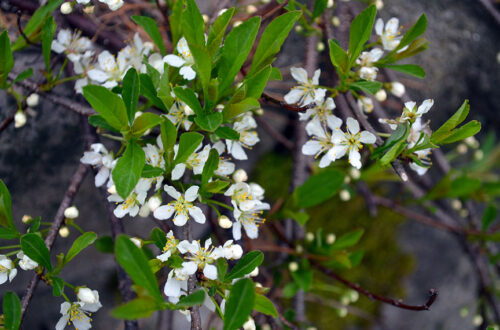By Duncan Brine
The garden world is in the midst of a slow-moving shift from the purely ornamental to the ecological. Today, naturalistic gardens are popular and prevalent. They fulfill a dual function: they are no longer just about the way they look, they are also about how they function ecologically.
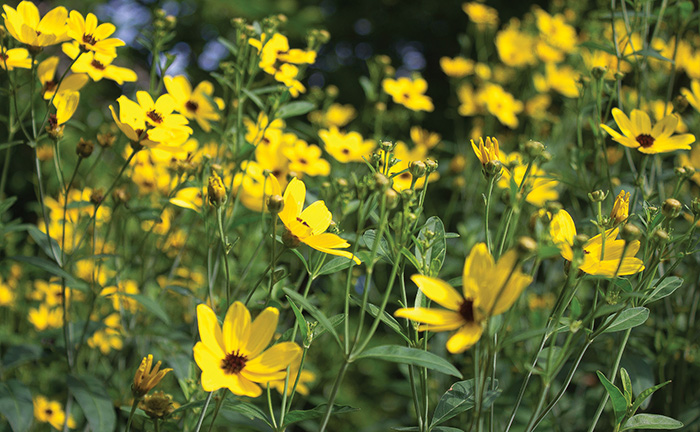
This article was first published by the Ecological Landscape Alliance in 2025
They’ve had a significant resurgence of late, but the naturalistic garden style has well-known historical antecedents, harkening back to the era of Britain’s prolific designer Capability Brown and his famous Blenheim Palace.
Doug Tallamy’s indefatigable efforts have raised environmental consciousness. He is largely responsible for bringing naturalistic gardens back to life.
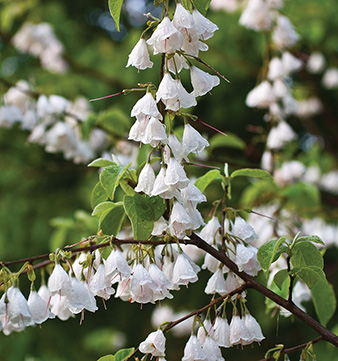
Reinforcing local ecosystems supports wildlife and native plant populations and provides services such as erosion control, flood control, water filtration, and the protection of aquatic species and pollinators.
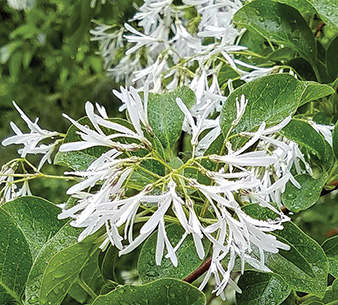
Chionanthus virginicus (Fringetree)
An essential aspect of the outdoors is how it improves our health and well-being. From a practical perspective, gardens continue their traditional role of pleasing people. We invest in and care for landscapes that appeal to us.
Unlike pure ecological restoration, a naturalistic garden features design preferences. By mimicking nature, these gardens bring native plants back to their original homes and communities where they support birds, mammals, butterflies, moths, and other insects displaced by habitat loss.
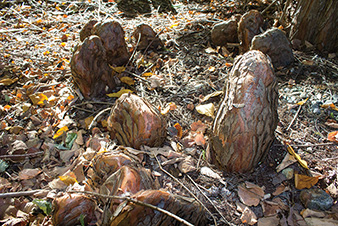
Habitats
Today’s ecological awareness couples with a naturalistic landscape approach. We recognize that landscape cannot revert to a former state. That’s not the goal. Restoration may be attempted, but always with the knowledge that lost habitat is lost. Complete restoration isn’t possible, but restoration can bring back the functions of a healthy ecosystem with the guidance of an ecological designer.
We guide forward movement by adding appropriate native plants and plant communities. We also allow space for new plant communities to take hold and evolve on the site. Ecological landscape design is informed by science; it’s measured and objective, while at the same time it’s married with a subjective, personal garden experience.
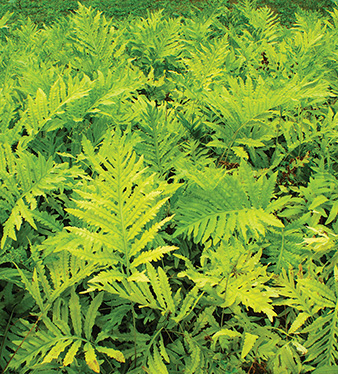
Onoclea sensibilis (Sensitive fern)
Habitat analysis asks, “What came before? What habitat was here before disturbance? What plant community matches the conditions on the site?” Data enhances a place by influencing the aspirations and preferences of the designer.
Habitat is a natural place which speaks of its conditions. When conditions change, supported species change. Ecological landscaping methods have s identifying and sustaining prevalent habitats with the plant choices that are made.
Routinely, we break down a client’s property and list its component parts, its habitats. We don’t attempt to change the habitat, instead we recognize the constraints of a given habitat and work within them to restore the function of the ecosystem for both wildlife and humans. Instead, habitat inspires the chosen aesthetic and practical goals.
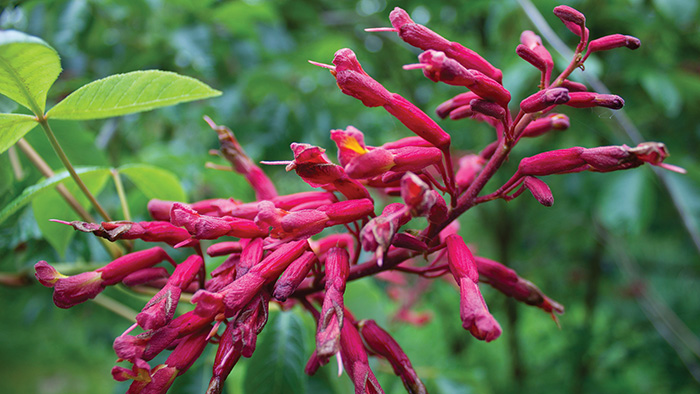
Oak Rocks
Oak Rocks, a 12-acre project my wife and partner, Julia Brine, and I are working on in Sherman, Connecticut, reveals the hybrid nature of naturalistic landscape design. It involves both science and art.
Concurrent with Artemisia vulgaris (mugwort) control, we expanded our target list of thuggish invasives to include woody invasives: Rosa multiflora (multiflora rose), Celastrus orbiculatus (bittersweet), Elaeagnus angustifolia (Russian olive), Lonicera maackii (bush honeysuckle), Ailanthus altissima (tree-of-heaven), Rhamnus cathartica (buckthorn), and Berberis thunbergii (barberry).
Barberry was the most congested and prevalent of these invasive species. When an expanse of large barberry was removed, stretches of exposed soil gave us room to plant hundreds of plugs. An ecological design seeks not only to protect extant plants, but to introduce more plants and increase a property’s plant diversity.
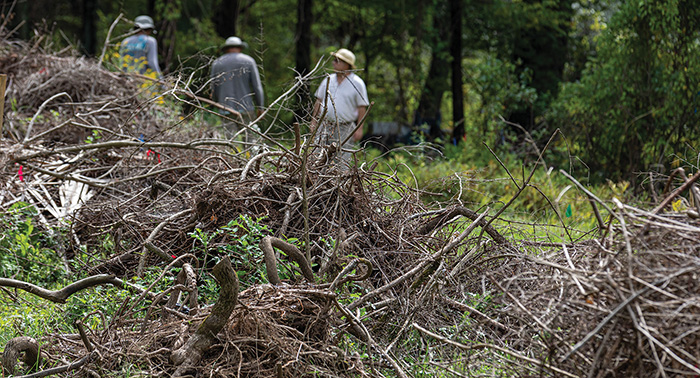
Together with the property owner, Carol, we determined that we wouldn’t use any chemicals at Oak Rocks. So, our primary means of invasive control relies on weed whacking – repeated, detailed weed whacking. Over time, with persistence, barberry and other invasives will diminish, and introduced natives will increase to shade sun-loving invasives, helping to starve their root systems and further their demise.
On a large project, design and management intertwine and overlap and the property is managed with intent. Conserving populations of native species requires control of invasive species.
Controlling invasives involves strategies to encourage introduced plants to outcompete established, undesirable plants. It’s about dominance. Not one piece of Japanese stiltgrass can be allow- ed to go to seed. There are a variety of techniques, but ultimately, whatever prohibits stiltgrass from further populating itself is what needs to happen.
The same goes for other invasive plant species. Once you’re responsible for a property, there must be a hard stop to invasives perpetuating themselves. We see to it that native plants spread and their root systems increase while invasives decrease. Time favors persistence.
Ecological procedures infuse naturalistic gardens with the excitement of discovery. Each morning, Carol, for as long as her battery lasts, weed whacks her property. She continuously looks up her discoveries on various apps. She and Julia confer, and Julia updates the relevant lists with Carol’s findings. We look forward to seeing how these lists change as more native plants are established.
Fortunately, Carol and Julia are both musical – they recognize bird calls. Together, so far, they’ve discovered 31 birds and 70 native plant species. It was particularly thrilling for Julia to hear – not see – the Scarlet Tanager and to spot a single Actaea pachypoda (doll’s eyes) in flower. Next up is to list the insects and moss at Oak Rocks.
Ecological landscape design and naturalistic gardens are a frame of mind. They comprise a set of design activities and a rewarding landscape practice. The study of ecosystems has joyful moments. Even small successes and discoveries like finding a single remnant native plant and augmenting it with others are exciting. Initiating successful plant regeneration is the ultimate reward.
Climate Change
It’s widely expected that climate change will deliver increasingly erratic weather. The second part of last year was so droughty it led to unprecedented forest fires throughout the northeast. The drought was preceded by rainy months when it seemed to rain every day.
After a prolonged rain event, I discovered several vigorous streams flowing across Carol’s long driveway. Because her garage was at risk of flooding and her driveway was at the point of washing out, we acted to conserve the integrity of Carol’s property.
Over months, in anticipation of winter’s onset, we hustled. We worked on machines alongside our excavator to create a system of swales and culvert pipes to capture surface and subterranean water and deliver it to an established wetland area, Oak Rocks.
Our grading and drainage efforts conserve habitat by expanding wetland, which allows for more plants and species diversity. Oak Rocks features an assortment of graminoids, Iris versicolor, and look-alikes, principally Acorus americanus. The composition, though extensive, is visually simple: similar vertical forms echo each other, while foreground groups repeat and connect with the background. Similar individuals form two complementary masses – the upright Iris and Acorus contrast with floppy, water-loving grasses. There’s an ocean of graminoids with a few vertical, eye-catching perennials to accent the area.
Massing Plants
Within the limitations of a given habitat, I’m free to explore plant texture, stature and color. However, selecting plants that are not only adapted to site conditions but also please both client and designer aesthetically, is an involving challenge.
At Oak Rocks, we found a 200-foot drift of Onoclea sensibilis (sensitive fern) buried beneath a dense cover of invasive plants. It’s a satisfying mass indeed. The abundance of the somewhat coarse fern inspired me to think of plants to partner it with.
Because wetlands periodically dry out, once established, many wetland plants including Onoclea and my favorite purple perennial, Vernonia noveboracensis (New York ironweed) are adapted to tolerate drought. For a natural look, I decided to pair the Onoclea with a comparable mass of Coreopsis tripteris (threadleaf tickseed) on the adjoining dry field. The relatively short Onoclea contrasts nicely with the statuesque, abundantly floriferous Coreopsis.
Internationally prominent public and private gardens, often influenced by landscape design master, Piet Oudolf, often feature approximately 10 feet of complimentary graminoids and perennials adjacent to one another. With Onoclea’s enthusiastic growth habit in mind, I propose that, when a site warrants, the scale of the plantings should be substantially larger than 10 feet.
Introducing native plants from a different eco-region has become controversial, but long ago in the Brine Garden we successfully involved charismatic native plants, particularly shrubs and trees populated south of us. Given climate change’s influence on habitat, I incorporated Aesculus parviflora (bottlebrush buckeye), Aesculus pavia (red buckeye), Calycanthus floridus (Carolina allspice), Chionanthus virginicus (fringetree), Cotinus obovatus (American smoketree), Halesia tetraptera (Carolina silverbell), Liquidambar styraciflua (sweet gum), Taxodium distichum (bald cypress), and others. All of these southerners are currently established and appreciated here in NY’s Hudson Valley, particularly Taxodium which is featured in an allée filled with marvelously distinctive knees.
As naturalistic landscape designers, our imagination is bound by the realities that the land, altered as it may be, presents. An ecological approach to design doesn’t reward idealists, but it pleases those closely involved in consciously evolving a property with a steady hand and a long perspective that calls for detailed actions on a large scale.
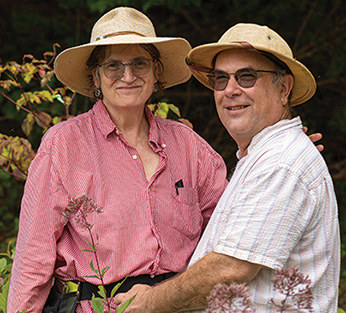
Duncan Brine is a principal naturalistic landscape designer at GardenLarge. Duncan and Julia Brine founded their design and installation firm in 1984. He’s an instructor of naturalistic landscape design at the New York Botanical Garden. The Brine Garden can be visited on Garden Conservancy Open Days on Saturday and Sunday, Oct. 18 & 19, 1-5 pm. To register go to gardenconservancy.org


